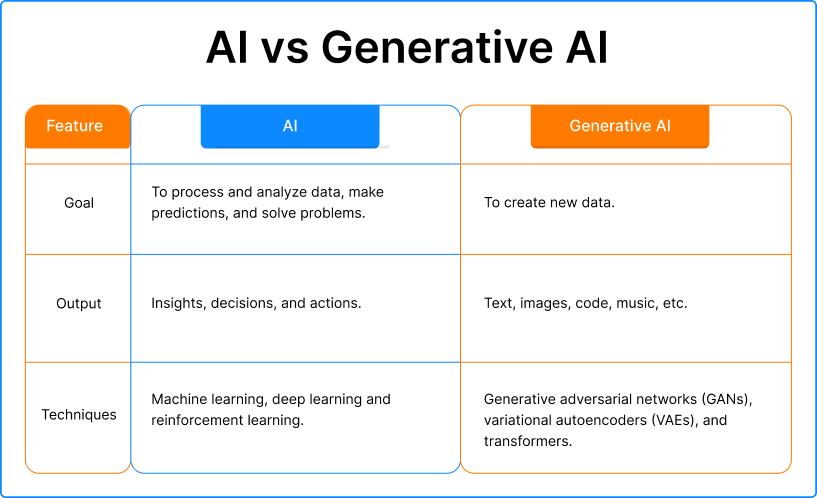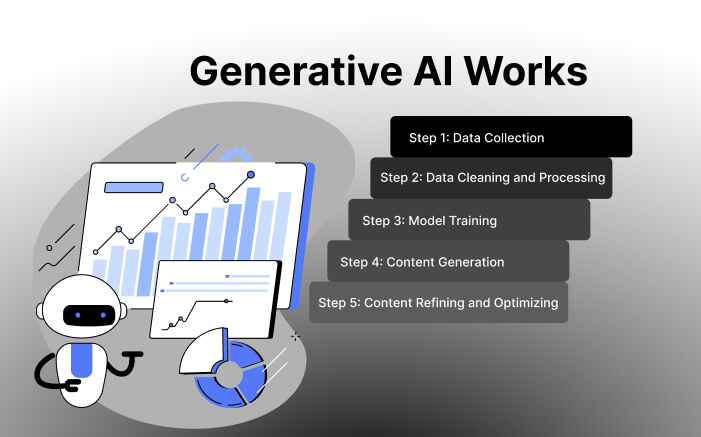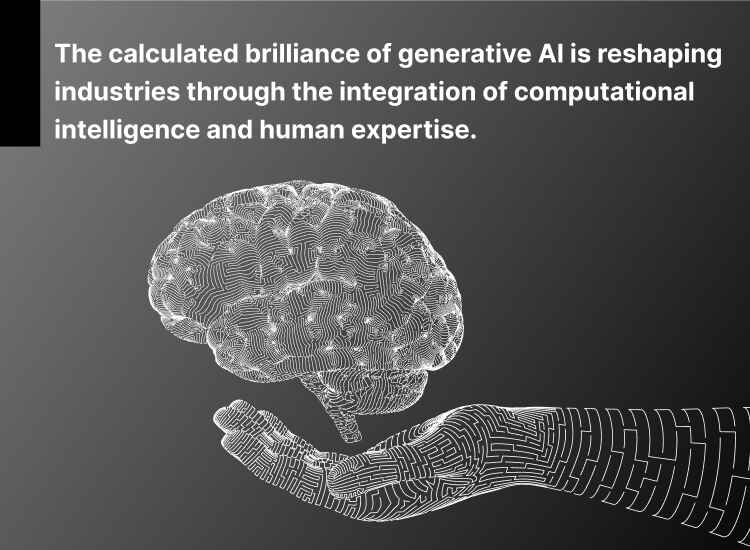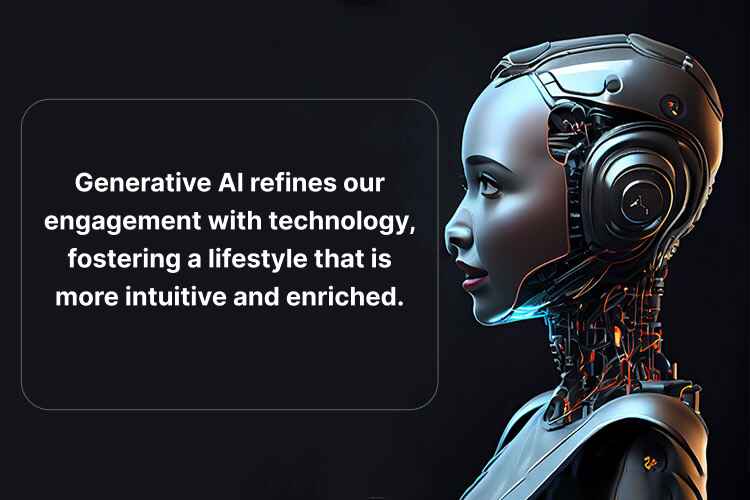The roots of generative AI can be traced back to the very beginning of AI research. The concept of machine learning emerged in 1950 paving the way for data-based algorithms. Following that, Joseph Weizenbaum develops the first chatbot in history ‘ELIZA’ in the 1960’s. The turning point started in the 2000’s. We are experiencing a massive wave of generative AI-enabled services. Generative AI has marked its footprints in various fields like art, design, healthcare, education, consulting, and more.
Let’s get into the details of what is generative AI, use cases, applications, and risk factors.
What is Generative AI?
“Generative AI is not just about copying the world; it’s about understanding the world and using that understanding to create new things.” – Demis Hassabis, DeepMind, co-founder
Generative AI is a deep learning model that facilitates raw data samples to self-train and produce new data based on user inputs. It can create new conversations, images, music, video, and many more creative generative results.
Types of Generative AI
Several types of generative AI models are commonly used in various applications. Here are a few notable ones:
- Variational Autoencoders (VAEs): VAEs are generative models that learn the underlying distribution of input data by encoding it into a lower-dimensional latent space and then reconstructing it. They are commonly used for tasks such as image generation, data compression, and anomaly detection.
- Generative Adversarial Networks (GANs): GANs consist of two neural networks: a generator and a discriminator. The generator generates synthetic data samples, while the discriminator learns to distinguish between real and generated samples. GANs are widely used for tasks like image synthesis, video generation, and data augmentation.
- Autoregressive Models: Autoregressive models generate output data by modeling the conditional probability of each element given the previous elements. Examples include language models such as LSTM (Long Short-Term Memory) or Transformer models used for natural language generation and text completion.
- Flow-Based Models: Flow-based models learn to map the input data to a probabilistic latent space using invertible transformations. This allows for efficient sampling and the generation of new data points. Flow-based models are often used in tasks like image generation and density estimation.
- Reinforcement Learning-based Models: Reinforcement Learning (RL) can be used to train generative models that generate sequences of actions. RL-based models have been used in tasks like game playing, dialogue systems, and robotic control.
- Evolutionary Algorithms: Evolutionary algorithms use natural selection and genetic operators to evolve a population of candidate solutions. They have been used for evolutionary art, music generation, and optimization problems.
Artificial Intelligence vs. Generative AI
Artificial Intelligence: AI or artificial intelligence is a machine-powered algorithm that is trained to perform functions associated with the human mind faster and more precisely. It collaborates with data sources and mimics human intelligence to produce content that resonates with human behavior.
Generative AI: Now, generative AI is one step ahead of AI (artificial intelligence). AI goes deeper into generative AI. Generative AI can be considered a specific application of AI. It utilizes many of the same underlying techniques and algorithms but with a distinct focus on content creation. It does not simply mimic user inputs like the previous artificial intelligence model. Generative AI can produce absolute raw and new content.
Text-Based Learning Models and Their Training Methods
Text-based machine learning models, such as language models, work by learning patterns and relationships within textual data to generate or understand text. They can be trained using various techniques, but one of the most common approaches is supervised learning. Here’s a high-level overview of how text-based machine-learning models are trained:
- Data Collection: The first step involves gathering a large corpus of text data relevant to the desired task. This can include books, articles, websites, social media posts, or any other text source.
- Data Preprocessing: The collected text data is then preprocessed to clean and prepare it for training. This can involve removing unnecessary characters or symbols, tokenization (splitting the text into individual words or subwords), and applying techniques like stemming or lemmatization to normalize the vocabulary.
- Feature Extraction: To represent the text numerically, various feature extraction techniques can be used. For example, the bag-of-words representation assigns a unique number to each word in the vocabulary and counts the occurrences of each word in a text sample. Other approaches, like word embeddings (e.g., Word2Vec or GloVe), assign dense vector representations to words in a continuous vector space, capturing semantic relationships.
- Model Training: Once the data is preprocessed and the features are extracted, the training process begins. Supervised learning involves training a model using labeled examples, where the input data (e.g., a sentence) is associated with a corresponding target (e.g., a sentiment label). The model is optimized to learn the statistical patterns and relationships between the input and output through an iterative process.
- Model Evaluation and Validation: After training, the model’s performance is evaluated using a separate dataset called the validation set. This helps assess how well the model generalizes to new, unseen data and allows for fine-tuning of hyperparameters or model architecture if needed.
- Deployment and Testing: Once the model is deemed satisfactory, it can be deployed for inference on new, unseen text data. This involves applying the trained model to make predictions or generate text based on the task it was trained for.
What are Some Shortcomings of Generative AI?
While generative AI has made significant advancements, it also has some shortcomings. Here are a few common limitations:
- Lack of Contextual Understanding: Generative AI models can struggle with understanding context and delivering accurate responses. They often generate responses based on patterns and statistical correlations in the training data without truly comprehending the meaning or intent behind the input.
- Over-reliance on Training Data: Generative AI models heavily rely on the data they are trained on. Biases or inaccuracies present in the training data can be reflected in the generated outputs, perpetuating existing biases or misinformation.
- Lack of Common Sense Reasoning: Generative AI models may struggle with common sense reasoning and logical inference. They can produce outputs that are factually incorrect or nonsensical, as they do not possess real-world experiences or a genuine understanding of the world.
- Difficulty in Handling Ambiguity: Ambiguous input can pose challenges for generative AI models. They may struggle to disambiguate and produce coherent responses, leading to outputs that are vague or irrelevant.
- Ethical and Misuse Concerns: The power of generative AI can also raise ethical concerns. There is a risk of misuse, such as generating misleading or harmful content, deepfakes, or spam. Safeguards and responsible use of generative AI are crucial to mitigate these risks.
- Resource-Intensive Training and Inference: Training generative AI models often requires significant computational resources and time. Additionally, generating outputs from these models can be computationally demanding, limiting their real-time applications or accessibility on low-powered devices.
ChatGPT and Its Dominance in Generative AI in 2023
ChatGPT is a language model developed by OpenAI. It was trained using Reinforcement Learning from Human Feedback (RLHF) and gained attention for its ability to generate coherent and contextually relevant responses in natural language conversations.
The history of ChatGPT can be traced back to the development of GPT-2, which was released in 2019. GPT-2 demonstrated impressive language generation capabilities, but due to concerns about its potential misuse, OpenAI initially limited its release. However, subsequent iterations and improvements led to the development of ChatGPT.
By 2023, ChatGPT has become a dominant force in generative AI. Through continuous training and fine-tuning, it has significantly improved in generating human-like responses and understanding nuanced contexts. Its widespread use in various industries, including customer support, virtual assistants, and content creation, has solidified its position as a leading language model.
DALL-E and the Innovations it Brought
DALL-E is another remarkable creation by OpenAI, combining the power of language models and image generation. It was unveiled in 2021 and stands out for its ability to generate unique and imaginative images from textual descriptions.
The development of DALL-E builds upon advancements in generative adversarial networks (GANs), the convergence of computer vision and natural language processing. It learned by looking at many pictures and their descriptions to understand the connection between what it sees and what it’s told.
DALL-E’s innovations lie in its capacity to create highly realistic images based on textual prompts that may not have been encountered during training. It has pushed the boundaries of what is possible in generative image synthesis. Then, it opened up new avenues for creative expression, design, and visual storytelling.
Google Bard and Continuous Contribution
Google Bard, a promising conversational AI, stands poised to make its mark on the ever-evolving landscape of artificial intelligence. Born from the vast knowledge ocean of Google AI, Bard possesses the remarkable ability to generate text, translate languages, and craft creative content, all while engaging in informative conversation.
Though still under development, Bard’s potential shines through its diverse skill set, encompassing thoughtful instruction execution, insightful question answering, and even artistic text generation.
This versatility not only opens doors for individual exploration and expression but also paves the way for democratizing AI, making its power more accessible to everyone. From fostering collaboration to fueling education and research, Bard’s journey is just beginning, and its impact on the AI community promises to be nothing short of transformative.
How Does Generative AI Work?
“Generative AI has the power to unlock new forms of human expression and creativity. It will push the boundaries of what’s possible and help us imagine and build a better future.” – Satya Nadella, Microsoft CEO
Generative AI produces data through the use of models that are trained on large datasets. These models, often based on neural networks, learn patterns and relationships within the data they are exposed to during the training process. Once trained, generative AI can generate new data samples that mimic the patterns of the original dataset.
Example:
Let’s consider a generative AI model trained on a dataset of handwritten digits (0-9). During training, the model learns the features and variations present in the dataset. Once trained, it can generate new, realistic-looking handwritten digits that were not part of the original dataset.
For instance, if the model encounters a sample of the digit ‘8’ during training, it learns the typical strokes, curves, and variations associated with the digit. After training, the generative AI model could then produce new, synthetic examples of the digit ‘8’ that were not present in the original dataset.
In summary, generative AI produces data by learning and replicating patterns from the input dataset, enabling it to create synthetic data that resembles the original and can be used for various applications, including image generation, text completion, and more.
Here’s a step-by-step breakdown:
Step 1: Data Collection
The first step is data collection. Generative AI gathers massive datasets from the existing content in the desired domain.
The data collection process runs on a variety of sources including books, articles, websites, social media posts, and anything available in the cloud. Data preparation and cleaning are the crucial focus at this step.
Step 2: Data Cleaning and Processing
The generative AI model then identifies and collects relevant data from various sources. To bring you the best answer from the prompt, it cleans data and arranges it into a format. The process may involve converting various file formats, aligning timestamps, and ensuring proper structure.
Then, the data goes through a few more cleaning processes like noise removal, bias detection and mitigation, consistency checks, and validation.
Step 3: Model Training
Now the actual magic begins! Here, a specific type of AI model, often a deep learning model like a neural network, is chosen.
This model is fed the prepped data and starts learning its subject matter. It analyzes patterns, relationships, and statistical probabilities within the data, understanding how words connect, images are structured, or music unfolds.
Training involves feeding the model the data repeatedly and fine-tuning its internal parameters through algorithms like backpropagation to minimize errors and improve its learning.
Step 4: Content Generation
“Generative AI is the future of content creation. It will democratize the ability to create high-quality content, making it accessible to everyone.”- Andrew Ng, Landing AI founder
Once trained, the model is ready to create! You provide it with a prompt or seed, which can be a text phrase, an image sample, or any relevant input in the chosen domain. The model then leverages its previously learned knowledge to generate new content.
This generation process can be iterative, with the model refining its output based on feedback or additional inputs. It leads to increasingly personalized results.
Step 5: Content Refining and Optimizing
Generative AI isn’t a one-and-done process. The models and generated content are constantly evaluated for accuracy, quality, and desired originality. If you make even minor changes to your prompt, generative AI might produce very different results compared to the previous.
Techniques like human validation, comparison with ground-truth data, and error analysis are used to identify areas for improvement. Based on these evaluations, the model can be further trained with additional data or adjusted in its parameters to generate better outputs over time.
Generative AI Applications and Examples
“Generative AI is still in its early stages, but it has the potential to revolutionize many aspects of our lives, from the way we create art and music to the way we design products and develop drugs.” – Jeff Dean, Google Senior Fellow, and Chief AI Scientist
The application of generative AI is diverse and it’s rapidly growing with new inventions. Here’s an explanation of 8 generative AI applications across various domains:
1. Text Applications
The use of generative AI in text applications is the most commonly adopted application. This usage includes generating articles, blog posts, social media content, emails, marketing copy, product descriptions, scripts, code, emails, letters, poems, code, scripts, musical pieces, emails, letters, etc.
Some more variants include translating text from one language to another accurately and efficiently. You can also use generative AI text applications to summarize long texts into shorter summaries.
Tools: Jasper, Writesonic, Copy.ai, Sudowrite, Rytr, Copysmith
2. Conversational Applications
These applications use advanced natural language processing and machine learning algorithms. For example, they use GPT-3. They generate human-like responses and engage users in dynamic, relevant conversations.
These applications closely mimic human communication. They can provide personalized and context-aware interactions across various domains. These include customer service, virtual assistants, and interactive content creation.
Chatbots are considered primarily conversational AI applications as they are designed to simulate conversation with humans, understand user input, generate responses, and maintain context throughout the interaction.
Tools: Bard, Kore, Cohere Generate, Avaamo, Yellow AI, Fireflies
3. Visual Applications
This advanced artificial intelligence can transform creative fields as well. It generates realistic images, artwork, and designs from textual descriptions or abstract concepts. This technology extends its reach to video generation. It enables the creation of videos with lifelike visuals and animations. This opens up new possibilities in the realm of digital content creation.
Additionally, generative AI plays a crucial role in photo editing. It offers tools to enhance images, remove imperfections, and apply artistic effects. This contributes to the refinement of visual content.
Tools: Midjourney, DALL-E, Synthesia, StyleGAN, Canva, Nightcafe
4. Audio Applications
Generative AI promotes advancements in AI-powered audio generation. This includes converting speech to text for documentation, accessibility, and searchability. Audio applications also include composing original music pieces in various styles.
It sets you all free from complex software usage. Moreover, the time-consuming process of audio generation is now faster than ever. Thanks to generative AI.
Tools: AudioCraft, Play.ht, Otter.ai, Transcribe, Murf.ai, Soundraw
5. Customer Service Applications
This is another application that has tremendously utilized generative AI. Many customer engagement platforms incorporate AI-enabled services. It helps provide automated support and answer customer queries effectively.
Several companies and industries can provide 5X enhanced customer services. Generative AI-supported chatbots offer personalized recommendations and solutions based on individual needs. This results in higher customer satisfaction.
Tools: REVE Chat, Zigpoll, Yuma AI, MeyaGPT
6. Personalized Learning Applications
Personalized lessons improve the effectiveness of education. Generative AI tools can help to design personalized courses and lesson plans. The education comes paired with technologies making learning more fun.
Generative AI can also help teachers in preparing their sessions better. For example, they can prepare quizzes, exercises, or questions for exams. They can prepare tailored study guides for individual students.
Tools: Duolingo, Mondly, ELSA Speak
7. Software Coding Applications
Generative AI has also revolutionized the field of software coding. It offers innovative approaches to streamline and automate the development process. Developers can use natural language interfaces to interact with the code. For example, with models like GPT-3. This enables a more intuitive and efficient coding experience.
Generative AI helps generate code snippets and automate repetitive tasks. It can even propose solutions to complex programming challenges. This technology has the potential to enhance collaboration among developers. It can understand and generate code in various programming languages.
However, developers need to remember that this may not produce flawless code. Thus, it will need their major involvement in software coding.
Tools: ChatGPT, Auto-GPT, GitHub Copilot, AlphaCode
Generative AI Use Cases
AI has been part of every growing sector in recent years. Generative AI is growing fast replacing more creative forms of mundane tasks. The new disruptive opportunities are making industries grow and improve productivity, with forward-thinking businesses leveraging AI business plan generators to capitalize on this trend. Let’s look at some use cases,
1. Healthcare Facilities
Previously, the healthcare industry faced several challenges to streamline its tasks. Generative AI came up with various solutions to assist healthcare industries in boosting their productivity. Some generative AI-backed healthcare facility task involves,
- Designing new molecules for targeted therapies and predicting their effectiveness.
- Tailored treatment plans based on individual genetic data and medical history.
- Automating diagnosis and disease detection at early stages.
- Supporting doctors and nurses with scheduling appointments, managing patient records, and answering FAQs with the help of virtual assistance.
2. Consulting Services
Generative AI in consulting is used in more than one way. It helps make reports adjustable and information representation reports for organizations in addition to other things. It also empowers data-driven insights. Structured data enables consultants to be more confident about their decisions. Some more benefits are,
- Preparing tailored proposals to specific client needs and preferences.
- Creating simulations for analyzing potential outcomes and mitigation strategies.
- Summarizing complex information and automating report writing.
3. Retail Sector
In retail generative AI emerged as a ground-breaking technology. It has simplified ground operations, automated regular tasks, and assisted creative sides. Imagine having a shopping experience so good that you get back to the same retail every time. Generative AI can create such experiences for retail sectors.
- Generating customized product recommendations and offering unique design options.
- Predicting demand and managing stock levels to avoid product shortages.
- Optimizing pricing strategies based on market trends and customer behavior.
- Creating personalized marketing campaigns and chatbot interactions.
4. Travel Industry
The travel industry is booming in 2024 and travelers are looking forward to having unparalleled travel experiences. This industry is heavily using generative AI to take travel and tourism one step ahead. Whether it’s an AI-powered travel assistant or booking assistance, generative AI is all on board to create memorable travel experiences.
- Suggest tailored itineraries and experiences based on user preferences.
- Optimizing pricing based on real-time demand
- Generating itineraries and booking flights, hotels, and activities.
- Answering customer questions, providing recommendations, and assisting with bookings with virtual travel assistance.
5. Marketing
Generative AI has been very promising to marketing sectors. From content to visual creation, AI is everywhere. Traditional marketing used to rely on human predictions. Marketers had to handle many time-consuming tasks manually. Generative AI has automated many of those monotonous tasks.
- Creating catchy ad copy, product descriptions, and marketing materials.
- Generating engaging posts and tailoring content for different platforms.
- Targeting specific customer segments with tailored messaging.
- Analyzing customer data to predict behavior and personalize marketing strategies.
6. Supply Chain
Supply chain management can also leverage generative AI. It trains supply chain data to provide accurate information. It facilitates the automation of routine tasks, freeing human resources for more strategic decision-making. The only challenge faced is the supply chain business model. Overly complex models lack transparency which might hinder AI-driven insights.
- Planning efficient routes and schedules for transportation and delivery.
- Identifying potential equipment failures and scheduling preventative maintenance.
- Accurately predicting product demand to optimize inventory and production.
- Identifying anomalies and potential fraud in supply chain operations.
7. Customer Support and Services
Conversational AI is the most commonly used generative AI in customer services and contact centers. It helps to improve real-time interaction. Chatbots have been revolutionary for these industries. Customer services can leverage both live chat and chatbot technology to provide a seamless experience.
- Providing 24/7 support, answering questions, and resolving simple issues.
- Understanding customer sentiment and identifying areas for improvement.
- Tailoring interactions to individual customer needs and preferences.
- Predicting potential problems and proactively addressing them before they impact customers.
The Risks of Generative AI
As generative AI brings us into the future where machines mimic human creativity, the landscape is both promising and precarious. The risks associated with thing technology cannot be ignored. There is a high risk that people can use generative AI for malicious purposes. We already have examples including deepfake videos, fake news, and other forms of misinformation.
As the system can reproduce from existing data. This raises concerns about exposing sensitive data and confidential details. There is also the risk of adversarial attacks. A slight modification to input data can lead to unexpected and potentially harmful outputs.
Generative AI systems are becoming more complex. Understanding how and why certain decisions or outputs are generated can be challenging. This lack of transparency can make it difficult to hold the system accountable for its actions.
End Note
Generative AI is increasingly becoming popular. It incorporates our regular lives and many industry sectors to fine-tune the task process. All we need is to recognize the best uses of generative AI and minimize risk factors. Striking a balance between innovation and responsibility is important to utilize the full potential of generative AI. It’s indeed a powerful tool.
;)









